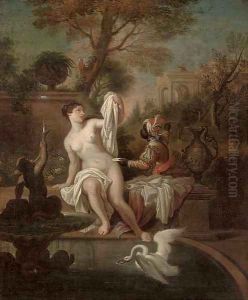Sebastian-Jacques Leclerc, Called Lerclerc Gobelins Paintings
Sebastian-Jacques Leclerc, also known as Leclerc des Gobelins, was a French engraver, draftsman, and painter born in 1734. He was the son of the engraver Sébastien Leclerc II and the great-grandson of the also famous Sébastien Leclerc, a prolific artist who largely contributed to the engravings of the era of Louis XIV. Leclerc des Gobelins was part of a family deeply entrenched in the artistic fabric of France, which enabled him to receive a comprehensive education in the arts from an early age.
Leclerc earned the moniker 'des Gobelins' because he was appointed as a designer at the famous Gobelins Manufactory, which was a prestigious tapestry factory supplying the French court and nobility with luxurious textiles. This position was significant because the Gobelins Manufactory was one of the most important centers of production for the decorative arts in 18th-century Europe, and being associated with it would have enhanced Leclerc's reputation and secured his livelihood.
Throughout his career, Leclerc produced a considerable body of work, including engravings and designs for tapestries, book illustrations, and various decorative schemes. His style reflected the transitional period from Rococo to Neoclassicism, which dominated the artistic landscape of his time. Leclerc's works were known for their elegance and clarity, often characterized by a refined use of line and a graceful composition.
Despite the artistic talents and contributions of Sebastian-Jacques Leclerc, his name is less well-known today compared to other artists of the period. His work, however, remains a part of the rich tapestry of French 18th-century art. He died in 1785, leaving behind a legacy that is appreciated by art historians and specialists studying the period and the Gobelins Manufactory's history.
